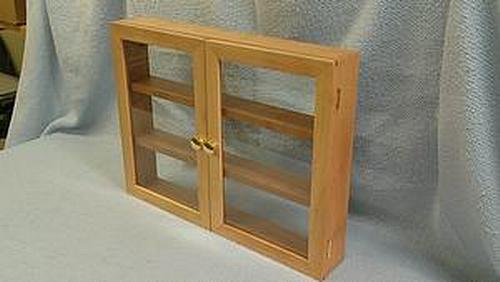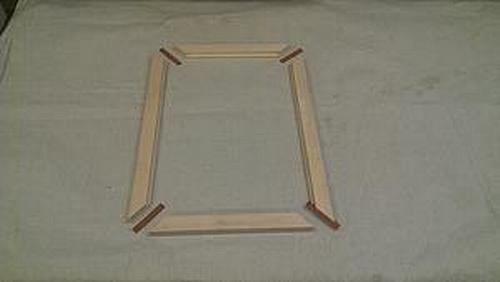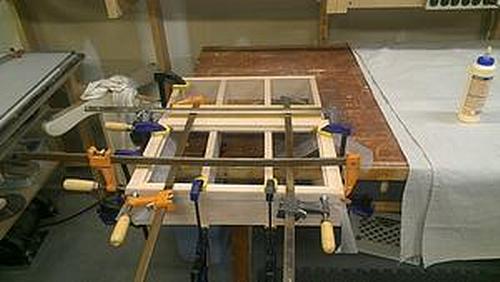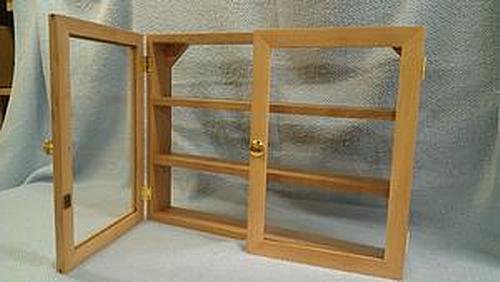While at the lumber yard picking out some wood for a bygone project, I came across some sycamore with an awesome grain pattern that really caught my attention. On impulse, I bought a single board of the sycamore figuring that I would find something to make from it. After watching it collect dust in my woodshop for about four years, one day I decided that the board would be ideal for making a small display case. I was also intrigued by the creative challenge of crafting a piece of furniture from a single piece of wood. Thus was born this sycamore display case.

Sycamore display case made from a single board
The display case measures 24″ wide by 18″ high by 3″ deep. Each door is 12″ wide by 18″ high. The total amount of lumber used is 4 board feet. It all came from a 3/4″ thick board that was about 7″ wide and 9′ long. The frame of the display case is held together with biscuits and glue. Nothing too fancy. It’s unlikely that the case will ever be subjected to much stress so I felt comfortable going with simple joinery.
The case doors are another story. They are held together using splined miter joints. If you’ve never tried this type of joint, you should. A conventional miter joint is not exceptionally strong by itself but when reinforced with a spline, it becomes considerably stronger because of the long-grain connection (versus just end-grain to end-grain). For the splines, I chose a dark red hardwood (Padauk I think) that contrasts nicely with the lighter-colored sycamore. It took a bit of effort to setup a jig on the table saw to cut the slots for the splines and to cut the splines to the exact right thickness to fit the slots. But once everything was configured properly, it didn’t take long to make all the cuts. I probably should have made some extra picture frames or something once it was all set up…

Door frame components including full-width splines
Perhaps the biggest challenge was gluing up the doors. Because the splines protrude beyond the outside corners, my miter frame clamp couldn’t be used because its pressure corners fit snugly against the outside corners of the frame being glued. Instead, I resorted to using a bunch of light weight bar clamps with trigger clamps to hold everything down flat against the case frame. It was tricky getting all the corners lined up properly before the glue set but I eventually got there. Note to self: come up with a better clamping system the next time I do splined miters. After allowing sufficient time for the glue to dry, I trimmed off the splines with a sharp chisel to lie flush with the door frame.

Gluing up the display case
For the door hardware, I opted for exposed brass hinges and knobs. The hinges were mortised in place using a chisel and router. Although a mortised hinge definitely requires more effort than a flush mount or concealed hinge, I think it’s the only way to go if one desires that classic cabinet look (which I did). The doors are held in the closed position with a single magnetic catch under the bottom shelf that is wide enough to make contact with both doors. Each door has a 3/16″ thick pane of glass that is secured into a routered recess on the inside of the door with a bead of silicon caulking.

Door frames reinforced with hardwood splines
There was one snafus with this project. After the case frame and doors were glued together, I decided to take a “very light” pass over the case sides with the jointer to save a little sanding time. Unfortunately, the jointer bed slipped down while jointing, resulting in a big gouge being taken out of one of the case sides. I was quite steamed about this and considered abandoning the whole project. But, after contemplating the situation, I came up with a rescue plan that involved ripping the damaged side to a uniform thickness and then positioning the hinges so the doors protruded out from the sides of the case rather than lining up flush. The case looks a little unusual with one side 3/16″ thicker than the other but as long as the doors are closed and one isn’t looking too closely, it’s not very noticeable. That’s my story and I’m sticking to it.

Basic brass door hardware
For the finish, I wiped on several coats of General Finishes Urethane with a light sanding between each coat using a nylon pad. This finish added a slight amber cast while still mostly preserving the sycamore’s natural lightness and intriguing grain pattern. The wood will no doubt get darker over time but hopefully the UV inhibitor in the finish will slow down the process.
All in all, the sycamore display case was an enjoyable, relatively simple project. It was an interesting challenge making something useful from a single board. It also gave me an opportunity to try out splined miter joinery for the first time. Now I just need to find a place to hang the display case and find enough knick-knacks to fill it up…

